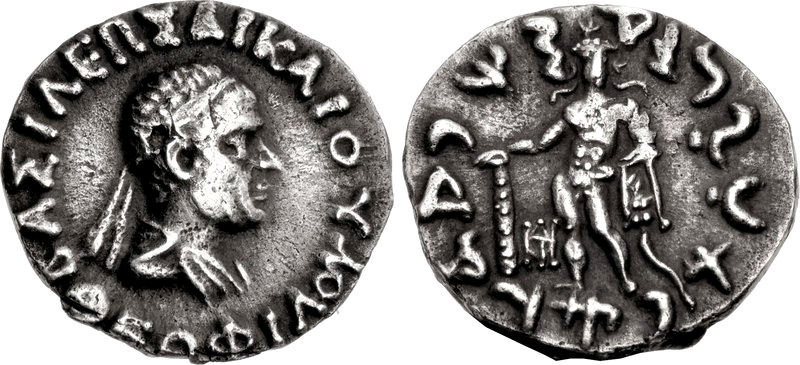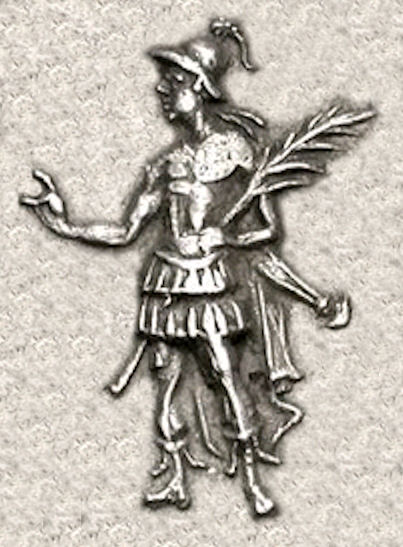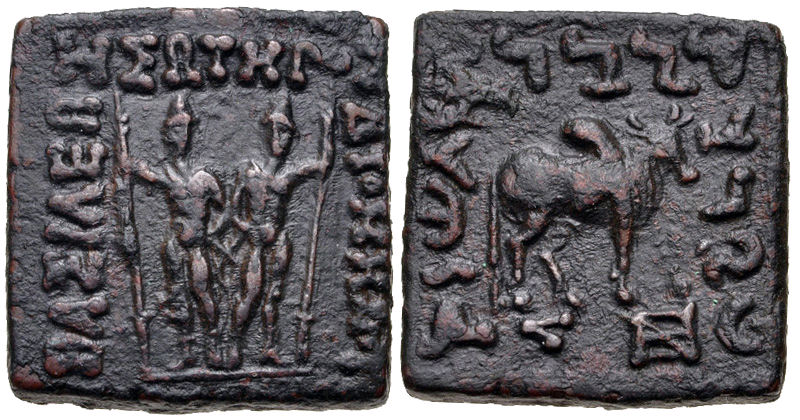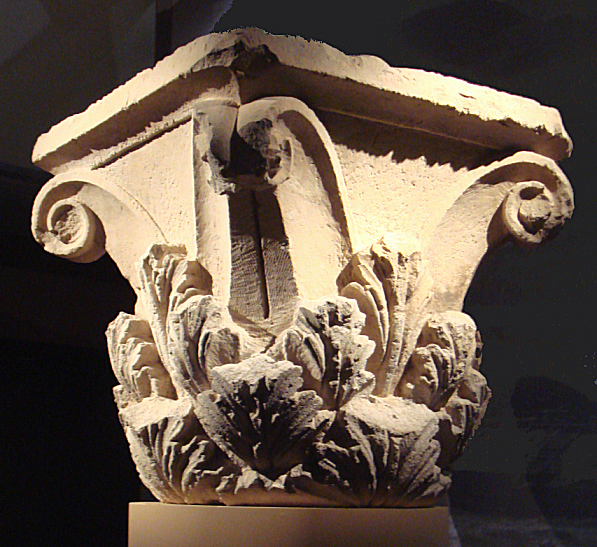|
Theophilus (Indo-Greek)
Theophilus Dicaeus () was a minor Indo-Greek king who ruled for a short time in the Paropamisadae. He was possibly a relative of Zoilus I and is only known from coins. It is possible that some of Theophilus' coins in fact belong to another ruler, in Greek Bactria, during approximately the same period. Time of reign While Bopearachchi suggests c. 90 BCE, R. C. Senior believes that Theophilus ruled in the 130s BCE. Both numismatics do however suggest that the reigns of Theophilus and Nicias were adjacent. Coins of Theophilos Just like Zoilus I, Theophilus struck Indian silver coins with Heracles, a common symbol of the house of Euthydemus I, and the epithet Dikaios/Dhramikasa ''"The Just/Follower of the Dharma".'' The monograms are mostly the same as those of Nicias. The bronzes have similar inscriptions. Bronzes of Theophilos: Image:Theophilos-634.jpg, Heracles with lion skin, and his club on the reverse. A Bactrian king Theophilus? There is a wholly different, and very rare, ... [...More Info...] [...Related Items...] OR: [Wikipedia] [Google] [Baidu] |
Indo-Greek
The Indo-Greek Kingdom, also known as the Yavana Kingdom, was a Hellenistic period, Hellenistic-era Ancient Greece, Greek kingdom covering various parts of modern-day Afghanistan, Pakistan and northwestern India. The term "Indo-Greek Kingdom" loosely describes a number of various Hellenistic states, ruling from regional capitals like Taxila, Sagala, Pushkalavati, and Bagram. Other centers are only hinted at; e.g. Ptolemy's ''Geographia (Ptolemy), Geographia'' and the nomenclature of later kings suggest that a certain Theophilos (king), Theophilus in the south of the Indo-Greek sphere of influence may also have had a royal seat there at one time. The kingdom was founded when the Graeco-Bactrian king Demetrius I of Bactria invaded India from Bactria in about 200 BC. The Greeks to the east of the Seleucid Empire were eventually divided to the Greco-Bactrian Kingdom, Graeco-Bactrian Kingdom and the Indo-Greek Kingdoms in the North Western Indian Subcontinent. During the two cent ... [...More Info...] [...Related Items...] OR: [Wikipedia] [Google] [Baidu] |
Greco-Bactrian Kingdom
The Greco-Bactrian Kingdom () was a Ancient Greece, Greek state of the Hellenistic period located in Central Asia, Central-South Asia. The kingdom was founded by the Seleucid Empire, Seleucid satrap Diodotus I, Diodotus I Soter in about 256 BC, and continued to dominate Central Asia until its fall around 120 BC. At its peak the kingdom consisted of present-day Afghanistan, Tajikistan, Uzbekistan and Turkmenistan, and for a short time, small parts of Kazakhstan, Pakistan and Iran. An extension further east, with military campaigns and settlements, may have reached the borders of the Qin (state), Qin State in China by about 230 BC. Although a Greek population was already present in Bactria by the 5th century BC, Alexander the Great conquered the region by 327 BC and founded many cities, most of them named List of cities founded by Alexander the Great, Alexandria, and further settled with Ancient Macedonians, Macedonians and other Ancient Greece, Greeks. After the death of Alexande ... [...More Info...] [...Related Items...] OR: [Wikipedia] [Google] [Baidu] |
Nicias (Indo-Greek King)
Nicias (Greek: , ''Nikías''; ) was an Indo-Greek king who ruled in the Paropamisade. Most of his relatively few coins have been found in northern Pakistan, indicating that he ruled a smaller principate around the lower Kabul valley. He was possibly a relative of Menander I. Time of reign Bopearachchi suggests that Nicias ruled c. 90–85 BC. This late date is supported by the absence of Attic coins (see below). R. C. Senior on the other hand places him as a successor of Menander, c. 135–125 BC, according to his interpretation of hoard findings. Regardless of which period is correct, the fact that Nicias ages visibly on his coins seems to indicate some longevity to his rule. The coinage of Nicias Nicias struck Indian silver drachms of diademed or helmeted king with three reverses: *A standing king in armour making a blessing gesture, found on several drachms. *An en face version of Menander's Athena with thunderbolt is found on a unique tetradrachm. *The third reverse is th ... [...More Info...] [...Related Items...] OR: [Wikipedia] [Google] [Baidu] |
Indo-Greek Kingdom
The Indo-Greek Kingdom, also known as the Yavana Kingdom, was a Hellenistic period, Hellenistic-era Ancient Greece, Greek kingdom covering various parts of modern-day Afghanistan, Pakistan and northwestern India. The term "Indo-Greek Kingdom" loosely describes a number of various Hellenistic states, ruling from regional capitals like Taxila, Sagala, Pushkalavati, and Bagram. Other centers are only hinted at; e.g. Ptolemy's ''Geographia (Ptolemy), Geographia'' and the nomenclature of later kings suggest that a certain Theophilos (king), Theophilus in the south of the Indo-Greek sphere of influence may also have had a royal seat there at one time. The kingdom was founded when the Graeco-Bactrian king Demetrius I of Bactria invaded India from Bactria in about 200 BC. The Greeks to the east of the Seleucid Empire were eventually divided to the Greco-Bactrian Kingdom, Graeco-Bactrian Kingdom and the Indo-Greek Kingdoms in the North Western Indian Subcontinent. During the two cent ... [...More Info...] [...Related Items...] OR: [Wikipedia] [Google] [Baidu] |
Diomedes Soter
Diomedes Soter (Greek: , ''Diomḗdēs Sōtḗr'', "Diomedes the Saviour") was an Indo-Greek king and possible claimant Greco-Bactrian king who may have attempted to reconquer the lands north of the Hindu Kush. He was likely a member of the Eucratid dynasty. The places where his coins have been found seem to indicate that his rule was based in the area of the Paropamisadae, possibly with temporary dominions further east. Judging from their similar portraits and many overlapping monograms, the young Diomedes seems to have been the heir (and probably a relative) of Philoxenus, the last king to rule before the kingdom of Menander I finally fragmented. Time of reign Bopearachchi dates Diomedes to c. 95–90 BCE and R. C. Senior dates him to c. 115–105 BCE. Coins of Diomedes Diomedes is depicted with the Dioscuri on his coins, either on horseback or standing; both types were previously used by Eucratides the Great, which suggests a dynastic link to the latter. It is however un ... [...More Info...] [...Related Items...] OR: [Wikipedia] [Google] [Baidu] |
Kushan Empire
The Kushan Empire (– CE) was a Syncretism, syncretic empire formed by the Yuezhi in the Bactrian territories in the early 1st century. It spread to encompass much of what is now Afghanistan, Eastern Iran, India, Pakistan, Tajikistan and Uzbekistan. Kushan territory in India went at least as far as Saketa and Sarnath, now near Varanasi district, Varanasi in Uttar Pradesh, where inscriptions have been found dating to the era of the Kushan emperor Kanishka the Great. The Kushans were most probably one of five branches of the Yuezhi confederation, an Proto-Indo-Europeans, Indo-European nomadic people of possible Tocharians, Tocharian origin, who migrated from northwestern China (Xinjiang and Gansu) and settled in ancient Bactria. The founder of the dynasty, Kujula Kadphises, followed Iranian and Greek cultural ideas and iconography after the Greco-Bactrian tradition and was a follower of the Shaivism, Shaivite sect of Hinduism. Two later Kushan kings, Vima Kadphises and Vasudeva ... [...More Info...] [...Related Items...] OR: [Wikipedia] [Google] [Baidu] |
Indo-Parthian Kingdom
The Indo-Parthian kingdom was a Parthian kingdom founded by Gondophares, and active from 19 CE to c. 226 CE. At their zenith, they ruled an area covering parts of eastern Iran, various parts of Afghanistan and the northwest regions of the Indian subcontinent (most of modern Pakistan and parts of northwestern India). The rulers may have been members of the House of Suren, and the kingdom has even been called the "Suren Kingdom" by some authors. The kingdom was founded in 19/20 when the governor of Drangiana ( Sakastan) Gondophares declared independence from the Parthian Empire. He would later make expeditions to the east, conquering territory from the Indo-Scythians and Indo-Greeks, thus transforming his kingdom into an empire. The domains of the Indo-Parthians were greatly reduced following the invasions of the Kushans in the second half of the 1st. century. They managed to retain control of Sakastan, until its conquest by the Sasanian Empire in c. 224/5. In Baluchistan, t ... [...More Info...] [...Related Items...] OR: [Wikipedia] [Google] [Baidu] |
Indo-Scythians
The Indo-Scythians, also known as Indo-Sakas, were a group of nomadic people of Iranic Scythian origin who migrated from Central Asia southward into the present-day regions of Afghanistan, Eastern Iran and the northwestern Indian subcontinent: present-day Pakistan and northern India. The migrations persisted from the middle of the second century BCE to the fourth century CE. The first Saka king in India was Maues/Moga (first century BCE) who established Saka power in Gandhara, the Indus Valley, and other regions. The Indo-Scythians extended their supremacy over the north-western subcontinent, conquering the Indo-Greeks and other local peoples. They were apparently subjugated by the Kushan Empire's Kujula Kadphises or Kanishka. The Saka continued to govern as satrapies, forming the Northern Satraps and Western Satraps. The power of the Saka rulers began to decline during the 2nd century CE after the Indo-Scythians were defeated by the Satavahana emperor Gautamiputra Satakarni. ... [...More Info...] [...Related Items...] OR: [Wikipedia] [Google] [Baidu] |
Greco-Buddhism
Greco-Buddhism or Graeco-Buddhism was a cultural syncretism between Hellenistic culture and Buddhism developed between the 4th century BC and the 5th century AD in Gandhara, which was in present-day Pakistan and parts of north-east Afghanistan. While the Greco-Buddhist art shows clear Hellenistic influences, the majority of scholars do not assume a noticeable Greek influence on Gandharan Buddhism beyond the artistic realm. Cultural interactions between ancient Greece and Buddhism date back to Greek forays into the Indian subcontinent from the time of Alexander the Great. A few years after Alexander's death, the Easternmost fringes of the empire of his general Seleucus were lost in a war with the Mauryan Empire, under the reign of Chandragupta Maurya. The Mauryan Emperor Ashoka would convert to Buddhism and spread the religious philosophy throughout his domain, as recorded in the Edicts of Ashoka. This spread to the Greco-Bactrian kingdom, which itself seceded from the Sele ... [...More Info...] [...Related Items...] OR: [Wikipedia] [Google] [Baidu] |
Graeco-Bactrian
The Greco-Bactrian Kingdom () was a Greek state of the Hellenistic period located in Central-South Asia. The kingdom was founded by the Seleucid satrap Diodotus I Soter in about 256 BC, and continued to dominate Central Asia until its fall around 120 BC. At its peak the kingdom consisted of present-day Afghanistan, Tajikistan, Uzbekistan and Turkmenistan, and for a short time, small parts of Kazakhstan, Pakistan and Iran. An extension further east, with military campaigns and settlements, may have reached the borders of the Qin State in China by about 230 BC. Although a Greek population was already present in Bactria by the 5th century BC, Alexander the Great conquered the region by 327 BC and founded many cities, most of them named Alexandria, and further settled with Macedonians and other Greeks. After the death of Alexander, control of Bactria passed on to his general Seleucus I Nicator. The fertility and the prosperity of the land by the early 3rd century BC led to the c ... [...More Info...] [...Related Items...] OR: [Wikipedia] [Google] [Baidu] |
Theophilos Dikaios
Theophilus is a male given name with a range of alternative spellings. Its origin is the Greek word Θεόφιλος from θεός (''theós'', "God") and φιλία (''philía'', "love or affection") can be translated as "Love of God" or "Friend of God", i.e., it is a theophoric name, synonymous with the name '' Amadeus'' which originates from Latin, Gottlieb in German and Bogomil or Bogumił in Slavic. Theophilus may refer to: People Arts * Theophilus Cibber (1703–1758), English actor, playwright, author, son of the actor-manager Colley Cibber * Theophilus Clarke (1776?–1831), English painter * Theophilos Hatzimihail (c. 1870–1934), Greek folk painter from Lesbos * Theophilus Presbyter (1070–1125), Benedictine monk, and author of the best-known medieval "how-to" guide to several arts, including oil painting — thought to be a pseudonym of Roger of Helmarshausen Historical * Theophilos (emperor) (c. 812–842), Byzantine Emperor (reigned 829–842), the second of th ... [...More Info...] [...Related Items...] OR: [Wikipedia] [Google] [Baidu] |
Bopearachchi
Osmund Bopearachchi (born 1949) is a Sri Lankan historian and numismatist who has specialized notably standardized the coinage of the Indo-Greek and Greco-Bactrian kingdoms. He is currently Emeritus Director of the CNRS at the École normale supérieure and Adjunct Professor of Central and South Asian Art, Archaeology, and Numismatics, University of California, Berkeley. Background Originally from Sri Lanka, Professor Bopearachchi received his Bachelor of Arts (General) Degree from the University of Kelaniya. In 1983 he joined a team of the CNRS at the École Normale Supérieure to further his studies. He received his Ph.D. in Art History and Archaeology from the Institute of Art and Archaeology at the Sorbonne University Paris I in 1987. In 1998, he completed his Habilitation at the Université de Paris-Sorbonne (Paris IV). Academic career In 1989, he became Research Specialist (''Chargé de Recherche'') at CNRS. In 1991, Osmund Bopearachchi published an extensive work on In ... [...More Info...] [...Related Items...] OR: [Wikipedia] [Google] [Baidu] |









